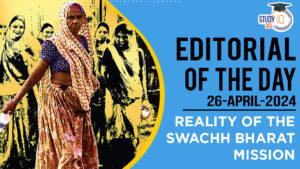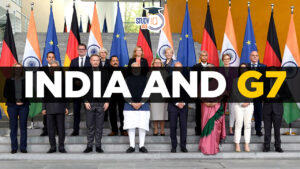Daily Current Affairs for UPSC 2023
Q) Recently seen in news, the ‘Carbon Border Adjustment Mechanism’ (CBAM) is related to which one of the following organizations?
- The Group of Twenty (G-20)
- United Nation framework convention on Climate Change
- The European Union
- United Nation Environment Program
Daily Current Affairs for UPSC – 20 February 2023
Explanation:
- Option 3 is correct: The European Union proposed the Carbon Border Adjustment Mechanism in 2021, in compliance with World Trade Organization (WTO) rules and EU’s other international obligations. EU aims to use CBAM to level the field on the fight against climate change by incentivizing developing countries to reduce their greenhouse gas emissions. CBAM aims to equalize the price of carbon between domestic products and imports, ensuring that the EU’s climate objectives are not undermined by production relocating to countries with less ambitious policies. Through CBAM, the EU claims to promote fair competition, leveling the playing field between EU and non-EU business partners. EU importers are required to buy carbon certificates based on the carbon price that would have been paid, had the goods been produced under the EU’s carbon pricing rules. The price of the certificates will be calculated based on the auction prices in the EU carbon credit markets. The amount of certificates required would be defined yearly by the quantity of goods and the embedded emissions in those goods imported into the EU. The CABM would apply initially to imports of cement, iron and steel, aluminium, fertilizers and electricity. If a non-EU producer is able to show that they have already paid a price for the carbon used in the production of the imported goods in a third country, the carbon cost can be fully deducted for the EU importer.
Q) Consider the following statements about ‘Sickle Cell Anaemia’ (SCA):
- It is a genetic disease caused by the malfunctioning of white blood cells.
- India has targeted eliminating SCA by 2050.
- SCA is prevalent in communities residing in areas where malaria is endemic.
Which of the statements given above is/are correct?
- 1 and 2 only
- 2 and 3 only
- 3 only
- 1, 2 and 3
Explanation:
- Statement 1 is incorrect: Sickle Cell Anaemia (SCA) is one of a group of inherited disorders known as sickle cell disease. It affects the shape of red blood cells (RBC), which carry oxygen to all parts of the body. Haemoglobin which is tasked with carrying oxygen to all parts of the body has four protein subunits-two alpha and two beta. In some people, mutations in the gene that creates the beta subunits impact the shape of the blood cell and distort it to look like a sickle. A round red blood cell can move easily through blood vessels because of its shape but sickle red blood cells end up slowing and even blocking, the blood flow. Sickle cells die early, resulting in a shortage of red blood cells that deprive the body of oxygen.
- Statement 2 is incorrect but statement 3 is correct: The Indian government has decided to work in “mission mode” to eliminate Sickle cell anaemia (SCA) by 2047. India is the second-worst affected country in terms of predicted births with SCA, that is, chances of being born with the condition. Prevalence of haemoglobinopathies is more common among tribal populations than non-tribal communities in India. Haemoglobinopathy is a group of disorders in which there is abnormal production or structure of the haemoglobin molecule. It is passed down through families (inherited). This group of disorders includes haemoglobin C disease, haemoglobin S-C disease, sickle cell anaemia, and thalassemias. SCA is prevalent in communities residing in areas where malaria is endemic. Research has found that those with sickle red blood cells were more likely to survive malaria. In India, prevalence of SCA is higher in communities that practice endogamy, as the chances of having two parents with sickle cell trait are higher.
Q) With reference to the ‘GST Appellate Tribunal’ (GSTAT), consider the following statements:
- A state can set up as many GSTAT benches as the GST Council approves.
- The GSTAT bench consists of such a number of judicial and technical members as the governor of the state decides.
Which of the statements given above is/are correct?
- 1 only
- 2 only
- Both 1 and 2
- Neither 1 nor 2
Explanation:
- Statement 1 is correct but statement 2 is incorrect: The Goods and Services Tax (GST) Council, in its 49th meeting, has approved the creation GST Appellate Tribunal. The GST Tribunal will have one principal bench in New Delhi and as many benches or boards in States as decided by each State, subject to approval of the Council. The bench shall have two judicial members and two technical members, with a senior judicial member of the State High Court in the selection panel. For a particular State bench, all judicial and technical members will be from that State. The establishment of GSTAT is expected to bring relief to businesses that have long awaited a quick and efficient process for resolving GST disputes. An appropriate appellate structure in the form of Tribunal will provide an effective and speedy resolution of disputes thereby lowering the judiciary’s burden. The expeditious constitution of GSTAT is expected to guarantee uniformity pan India and faster redress of grievances. It will also facilitate the “ease of doing business” and further make the country a lucrative destination for trade. It will assist both the Union and the State Governments, reducing conflicts between them and ensuring uniformity in dispute resolution. The tribunals are more adaptable than regular courts; they provide justice more quickly and are economical. The fact that tribunal’s procedures are simple enough for a layperson to understand makes them one of the most popular Alternative Dispute Resolution (ADR) options.
Q) Consider the following statements about ‘Rhododendron’:
- They are considered an indicator species for climate change.
- They require slightly basic soil to grow properly.
- Around one-third of all rhododendron species in India are found in the Darjeeling and Sikkim Himalayas.
Which of the statements given above is/are correct?
- 1 only
- 2 and 3 only
- 1 and 3 only
- 1, 2 and 3
Explanation:
- Rhododendron, meaning rose tree in Greek, are a diverse genus of about 1,000 species of woody flowering plants in the heath family (Ericaceae). They are native to the temperate regions of Asia, North America, and Europe, as well as to the tropical regions of south-east Asia and northern Australia and are notable for their attractive flowers and handsome foliage. They occur in a variety of habitats, including alpine regions, coniferous and broadleaved woodlands, temperate rain forests, and tropical jungles.
- Statement 1 is correct but statement 2 is incorrect: Rhododendron exhibit an enormous diversity of size and shape, from prostrate ground covers growing not more than few inches high to trees more than 100 feet tall. They are considered an indicator species for climate change and require a slightly acid soilto grow well.
- Statement 3 is correct: Darjeeling and Sikkim Himalayas comprise only 0.3% of India’s geographical area but is home to one-third (34%) of all Rhododendron types. They were first recorded in Jammu and Kashmir in 1776 and later in 1848 and 1850 in Sikkim and Darjeeling Himalayas. They are known as “Lali Guras” in local language and is the national flower of Nepal and the state tree of the state of Uttarakhand in India.
Q) The military exercise ‘Dustlik’ was recently conducted between which of the following countries:
- India and Kazakhstan
- India and Kyrgyzstan
- India and Turkmenistan
- India and Uzbekistan
Explanation:
- Option 4 is correct: The 4th edition of joint military exercise ‘DUSTLIK’ between the Indian Army and Uzbekistan Army was conducted recently. Uzbekistan is significant to India in terms of security, connectivity to Iran and the Central Asian region, and as an alternative to Afghanistan. This joint exercise focuses on joint counter-terrorist operations in the mountainous and semi-urban scenario, under UN mandate. The training schedule focuses primarily on sharing tactical-level drills and learning of best practices from each other. It includes field training exercises, combat discussions, lectures, demonstrations and culminates with a validation exercise. Both Armies jointly train, plan and execute a series of tactical drills for neutralisation of likely threats, while learning to exploit new generation equipment and technology for conducting joint operations. It aims at enhancing understanding, cooperation and interoperability between two armies.


 Current Affairs 26th April 2024 for UPSC...
Current Affairs 26th April 2024 for UPSC...
 Editorial of the day (26th Apr): Reality...
Editorial of the day (26th Apr): Reality...
 India And G7, India has Received Invitat...
India And G7, India has Received Invitat...

















